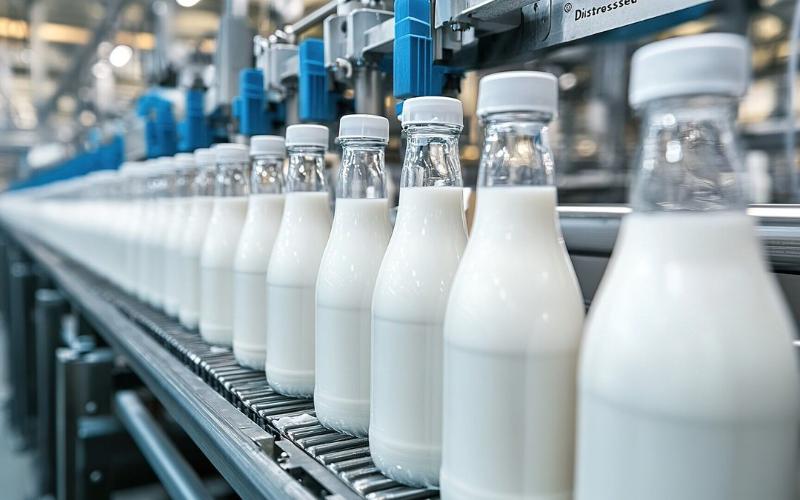School Milk Sugar Levels Drop 10% Following IDFA's Healthy School Milk Commitment
Sourse: DairyNews.today
As National School Lunch Week commences, the International Dairy Foods Association (IDFA) has reported a significant 10% reduction in added sugars across flavored school milk, achieved through its Healthy School Milk Commitment.

This initiative, launched in April 2023 with the backing of 37 school milk processors representing approximately 95% of the U.S. school milk market, aims to provide healthier milk options for schoolchildren.
Between the 2023 and 2024 school years, the added sugar content in flavored school milk, including popular options like chocolate milk, dropped from 8.2 grams per serving to 7.4 grams. This reduction equates to 2.7 billion grams, or 5.9 million pounds, of sugar removed from school milk products nationwide over the past year.
The Healthy School Milk Commitment sets a cap of 10 grams of added sugar per 8-ounce serving, aligning with the U.S. Department of Agriculture's (USDA) school meal nutrition guidelines. IDFA’s commitment, established over a year before the USDA finalized its updated school nutrition standards, now extends beyond the school year, also encompassing USDA’s Summer Food Service Program. This program provides nutritious meals to as many as 3.2 million low-income children and teens during the summer months. In February 2024, the Biden-Harris administration recognized the Commitment as part of its National Strategy on Hunger, Nutrition, and Health.
“These results demonstrate how America’s school milk processors continue to find ways to ensure children enjoy milk’s 13 essential nutrients in a product they love,” said IDFA President and CEO Michael Dykes. “The Healthy School Milk Commitment ensures that all children, especially those most vulnerable, have access to nutritious milk options with less added sugar and fewer calories.”
The IDFA reports that, since 2006, flavored milk products in schools have seen a 55% reduction in added sugars—from 16.7 grams to 7.4 grams per serving—while calories have dropped from 166 to under 125 calories per 8-ounce serving. Given that more than two-thirds of milk consumed by schoolchildren is flavored, these reductions are crucial for enhancing child nutrition across the country.
School milk remains the leading source of essential nutrients, including high-quality protein, calcium, vitamin D, and potassium, for children aged 2 to 18. IDFA underscores that milk consumption correlates with improved bone health, a lower risk of type 2 diabetes, and cardiovascular benefits, particularly among children who consume flavored milk, as they generally achieve higher intake levels of key nutrients.
The IDFA, headquartered in Washington, D.C., represents the U.S. dairy industry, which supports over 3.2 million jobs and contributes $794 billion in economic impact. Its members range from multinational corporations to small, single-plant companies, all dedicated to providing safe, nutritious dairy products to consumers in the U.S. and worldwide.
For more information about the Healthy School Milk Commitment, visit healthyschoolmilk.org.
Between the 2023 and 2024 school years, the added sugar content in flavored school milk, including popular options like chocolate milk, dropped from 8.2 grams per serving to 7.4 grams. This reduction equates to 2.7 billion grams, or 5.9 million pounds, of sugar removed from school milk products nationwide over the past year.
The Healthy School Milk Commitment sets a cap of 10 grams of added sugar per 8-ounce serving, aligning with the U.S. Department of Agriculture's (USDA) school meal nutrition guidelines. IDFA’s commitment, established over a year before the USDA finalized its updated school nutrition standards, now extends beyond the school year, also encompassing USDA’s Summer Food Service Program. This program provides nutritious meals to as many as 3.2 million low-income children and teens during the summer months. In February 2024, the Biden-Harris administration recognized the Commitment as part of its National Strategy on Hunger, Nutrition, and Health.
“These results demonstrate how America’s school milk processors continue to find ways to ensure children enjoy milk’s 13 essential nutrients in a product they love,” said IDFA President and CEO Michael Dykes. “The Healthy School Milk Commitment ensures that all children, especially those most vulnerable, have access to nutritious milk options with less added sugar and fewer calories.”
The IDFA reports that, since 2006, flavored milk products in schools have seen a 55% reduction in added sugars—from 16.7 grams to 7.4 grams per serving—while calories have dropped from 166 to under 125 calories per 8-ounce serving. Given that more than two-thirds of milk consumed by schoolchildren is flavored, these reductions are crucial for enhancing child nutrition across the country.
School milk remains the leading source of essential nutrients, including high-quality protein, calcium, vitamin D, and potassium, for children aged 2 to 18. IDFA underscores that milk consumption correlates with improved bone health, a lower risk of type 2 diabetes, and cardiovascular benefits, particularly among children who consume flavored milk, as they generally achieve higher intake levels of key nutrients.
The IDFA, headquartered in Washington, D.C., represents the U.S. dairy industry, which supports over 3.2 million jobs and contributes $794 billion in economic impact. Its members range from multinational corporations to small, single-plant companies, all dedicated to providing safe, nutritious dairy products to consumers in the U.S. and worldwide.
For more information about the Healthy School Milk Commitment, visit healthyschoolmilk.org.













